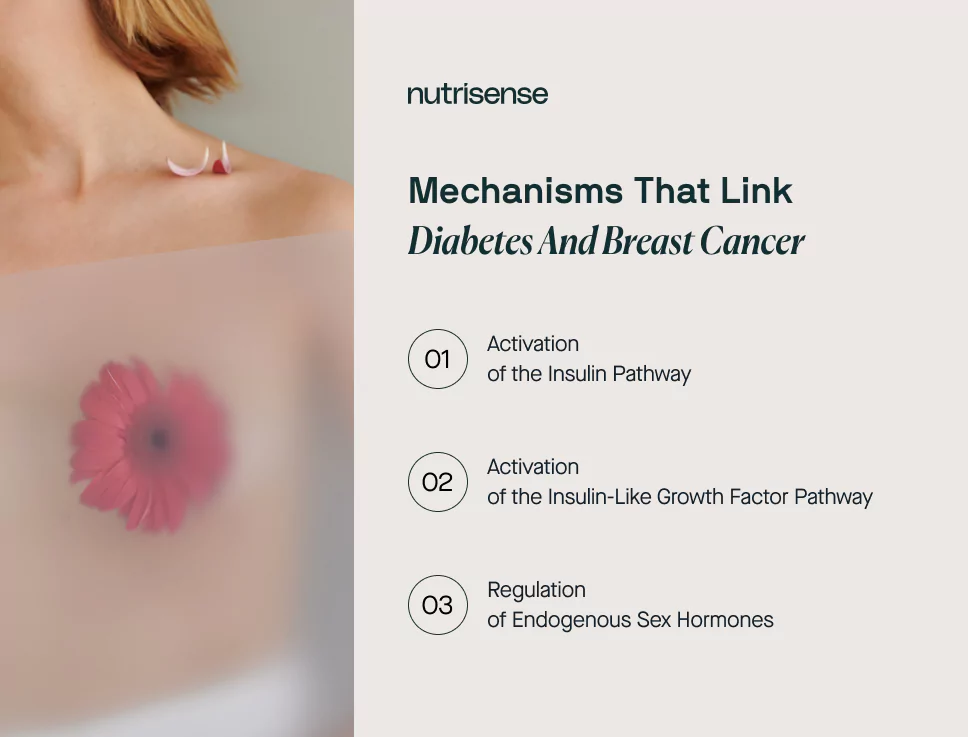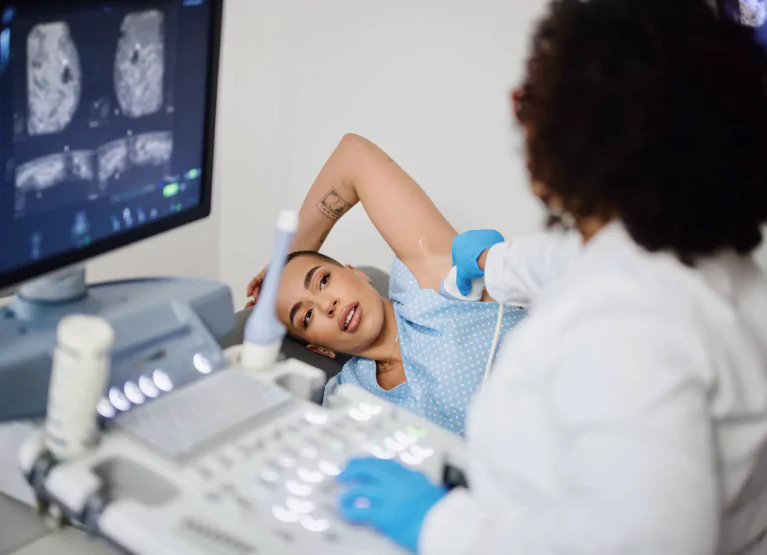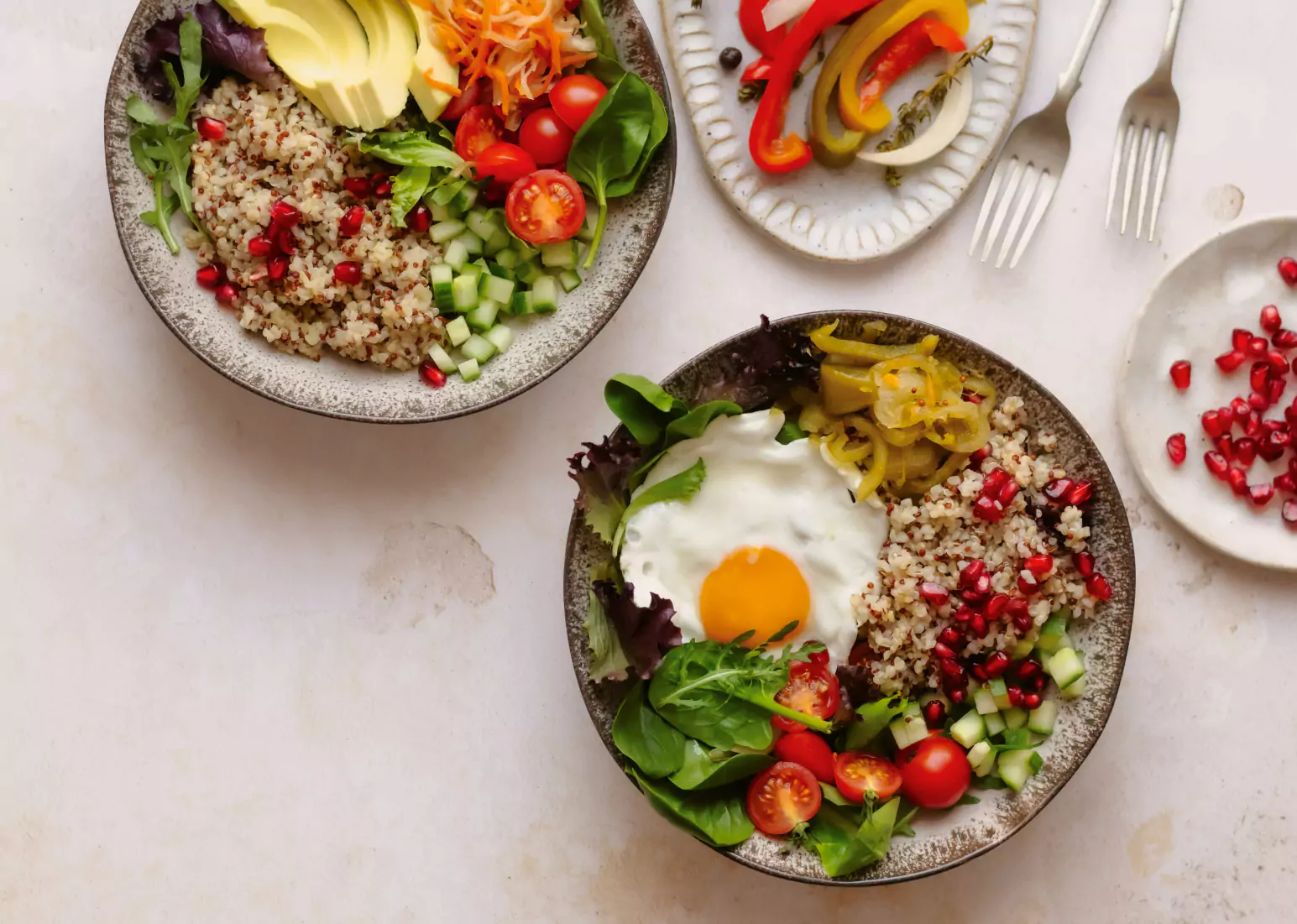Breast Cancer and Blood Sugar: What You Need to Know

Key Takeways
Breast cancer is the most prevalent cancer in women, accounting for a third of cancer diagnoses affecting women every year. Diabetes is one of the most prevalent chronic diseases in existence, affecting millions of people around the globe. And unfortunately, these two conditions are more interconnected than you might think.
Can Breast Cancer Cause High Blood Sugar?
The road goes both ways. People with diabetes have a higher breast cancer incidence and mortality rate. A 2022 study published in the Journal of Nature Cell Biology also found that breast cancer might suppress insulin response, which can itself encourage the development of diabetes.
So, how is the risk for one impacted by the other? Can breast cancer increase your risk for diabetes?
Let’s take a deeper look at the science behind breast cancer and diabetes and how these two diseases might impact each other.
Sugar and Breast Cancer
Higher amounts of added sugar in your diet may contribute to insulin resistance and risk for prediabetes or type 2 diabetes over time. Authors of a 2022 study released in the Journal of Missouri Medicine state: “In humans, when added sugar is restricted to less than five percent of total caloric intake there is an approximate 50 percent reduction in the prevalence of prediabetes/type 2 diabetes.”
"Sugar from your diet doesn’t directly cause breast cancer, per se. However, eating higher amounts of sugar, including sugar-sweetened beverages, candy, and desserts may lead to weight gain as well as insulin resistance, both of which may increase the risk of breast cancer." - Heather Davis, MS, RDN, LDN

Links Between Diabetes and Breast Cancer
Diabetes mellitus is a chronic condition that affects how your body uses sugar in your blood, or glucose, for energy. When your blood sugar goes up, your pancreas releases insulin, which allows the glucose to enter the body’s cells to be used as energy.
So, why is diabetes so closely linked to breast cancer? There are three mechanisms that have been shown to associate these two conditions:
- The insulin pathway
- The insulin-like growth factor pathway
- Endogenous sex hormone metabolism
For people with diabetes, the body does not make enough insulin or is not able to use it effectively, which means that their cells aren’t able to absorb the glucose from the bloodstream. When your body can’t make use of insulin, your blood glucose levels remain higher, which can lead to serious health problems over time.
A meta-analysis on diabetes and breast cancer found that type 2 diabetes may be associated with a 10 to 20 percent increased risk of breast cancer diagnosis, especially among women with estrogen receptor-positive breast cancer.
Hormone receptor positive breast cancer cells, such as estrogen receptor-positive breast cancers, will contain estrogen receptors that interact with the hormones estrogen and stimulate cell growth.
Elevated blood glucose is associated with a poor prognosis in breast cancer patients. Furthermore, for breast cancer patients who have type 2 diabetes prior to diagnosis, the mortality rate is higher compared to patients who don’t have diabetes. This is also true for women who are longer-term survivors of metastatic breast cancer.
1) Activation of the Insulin Pathway
Insulin receptors are often overexpressed in breast cancer. These receptors will respond to the growth-promoting effects of insulin. Increased insulin resistance can lead to high levels of insulin in the blood.
More insulin in the blood may reduce estrogen production and can increase synthesis of androgen hormones. Increased androgen levels have been linked to an increased risk of breast cancer.
2) Activation of the Insulin-Like Growth Factor Pathway

Hyperglycemia, or high blood sugar, is associated with increased levels of insulin-like growth factor 1 (IGF-1). IGF-1 is a hormone that manages the effects of growth hormone in your body. Increased levels of IGF-1 can increase inflammatory cytokines, which can directly and indirectly influence cancer cell reproduction, cell death, and metastasis.
3) Regulation of Endogenous Sex Hormones
Insulin resistance and reduced estrogen production can result in a metabolic disorder that contributed to the development of breast cancer, ovarian cancer, and cancer of the endometrium. As we mentioned earlier, insulin resistance can increase the production of androgen hormones and decrease the production of estrogen.
Insulin and Cancer
We’ve talked a lot about how diabetes and insulin resistance may increase risk for breast cancer, but this may be somewhat of a two-way street.
Some studies show that breast cancer cells can impair the function of pancreatic islets and make them produce less insulin than needed.This can lead to higher blood sugar levels in breast cancer patients.
Research also shows that cancer cells use more glucose than healthy cells in order to fuel tumor growth. Chronic high blood sugar can contribute to the growth of tumors and deprive nutrients from other cells.
However, studies have found that slow-releasing insulin pellets or a glucose-lowering drug known as an SGLT2 inhibitor restored normal control of glucose in the presence of a breast tumor, which in turn suppressed the tumor’s growth.
Risk Factors for Breast Cancer

Lifestyle Factors
There are some factors for breast cancer that can increase your risk of getting the disease. These include lifestyle-related factors, and others are factors that you cannot change, such as genetics. Lifestyle-related risk factors for breast cancer include:
- Drinking alcohol
- Obesity or high body mass index (BMI)
- Not being physically active
- Not breast-feeding
- Taking hormonal contraceptives
- Hormonal replacement therapy
- Having chest radiation
- Being exposed to certain drugs or compounds such as DES, a synthetic form of estrogen
In some studies, smoking tobacco led to an increased risk, but there are conflicting results. Other research shows that women who work night shifts might have an increased risk of breast cancer. This may be due to changes in levels of melatonin, but other hormones are also being studied to determine a cause.
Hereditary Risk Factors
About five to 10 percent of breast cancer cases are thought to be hereditary. Genetic risk factors for breast cancer include:
- Having a personal or family history of breast cancer
- Being born female
- Being taller
- Having dense breast tissue or certain benign breast conditions such as fibrocystic breasts
- Starting menstrual periods early
- Going through menopause later. Postmenopausal women may have a greater risk of developing breast cancer
Inheriting certain gene changes are another factor that can lead to a higher risk of breast cancer risk. These genes include:
- BRCA1 and BRCA2
- ATM, which is a gene that normally helps repair damaged DNA (or helps kill the cell if the damaged cell can't be fixed)
- PALB2, a gene that makes a protein that interacts with the protein made by the BRCA2 gene
- TP53, which helps stop the growth of cells with damaged DNA
- CHEK2, which is another gene that normally helps with DNA repair
- PTEN, which normally helps regulate cell growth
- CDH1, which can lead to an increased risk of invasive lobular breast cancer
- STK11, which controls cell growth
Race and ethnicity are other genetic factors that can make a breast cancer diagnosis more likely. For example, white women are slightly more likely to develop breast cancer compared to African American women.
In women under age 40, breast cancer is more common in African American women. African American women are also more likely to die from breast cancer at any age. Asian, Hispanic, and Native American women have a lower risk of developing and dying from breast cancer.
Nutrition and Breast Cancer: A Closer Look

To reduce your breast cancer risk, the American Cancer Society recommends eating a diet rich in vegetables, fruits, and whole grains. In fact, research has shown that the Mediterranean diet, which consists primarily of fish, vegetables, legumes, fruit, olives, and extra-virgin olive oil, is associated with a 46 percent decrease in breast cancer risk.
A higher intake of foods that contain omega-3 fatty acids (such as fatty fish), adequate vitamin D, fiber, and folate, are also associated with lower breast cancer risk.
On the other hand, consuming a lower intake or limiting saturated fat, omega-6 fatty acids, grilled meats, alcohol, red and processed meats, and fewer sweets may also lower your risk of cancer.
However, more research is needed to determine the exact relationship between diet and breast cancer risk. The same may also be true for supplements, as no research has been able to conclude that taking specific vitamin supplements reduces your risk for breast cancer.
Fruits and Vegetables
Vegetables appear to have strong anticancer effects, which may be due to their phytonutrient content. These compounds, which are also found in fruit, include bioactives like flavonoids that may help modulate oxidative stress and cell signaling.
Fruits and vegetables are also rich in fiber, which is associated with reduced cancer risk. However, a very high intake of fruit and juice has also been associated with increased insulin levels, which could encourage tumor growth. When it comes to fruit, it’s a good idea to stick to the recommended two cups of fruit per day.
Soy Products

Multiple studies of women in Asian countries have shown that diets high in soy products may lower the risk of breast cancer. However, this link hasn’t yet been reproduced in studies of women in Western countries.
Some researchers believe this could be because Asian women tend to have more soy products in their diet, and start consuming soy at an earlier age than non-Asian women. However, more research is needed to establish a definitive link between soy and cancer risk.
Dietary Fat
The link between dietary fat and breast cancer risk is still debated. The Susan G. Komen Foundation compiled a summary of the studies done in this area, looking at the quality of the studies and its findings.
No definitive link between dietary fat intake in adulthood and cancer risk was found, but researchers believe that the type of fat in your diet may be important. Research in this area is still ongoing.
How Breast Cancer May Worsen Insulin Resistance
We’ve talked a lot about how diabetes and insulin resistance may increase risk for breast cancer, but there are new scientific findings that suggest this may be somewhat of a two way street.
For example, some studies show that breast cancer cells can impair the function of pancreatic islets and make them produce less insulin than needed.This can lead to higher blood sugar levels in breast cancer patients.
Research also shows that cancer cells use more glucose than healthy cells in order to fuel tumor growth. Chronic high blood sugar can contribute to the growth of tumors and deprive nutrients from other cells.
However, studies have found that slow-releasing insulin pellets or a glucose-lowering drug known as an SGLT2 inhibitor restored normal control of glucose in the presence of a breast tumor, which in turn suppressed the tumor’s growth.
Supporting Healthy Glucose Metabolism

If you are concerned about your metabolic health and want to keep your blood sugar in check, there are certain lifestyle changes that may help support a healthy glucose metabolism. Read about how the Nutrisense program helped support one member's goals to make healthy diet and lifestyle changes after her recovery from breast cancer here.
Watch Your Carb Intake
Eating the appropriate amount of carbohydrates for your activity levels and individual health can help support healthy blood sugar levels. When you eat carbohydrates, your body converts them into glucose, causing your blood sugar levels to rise.
Prolonged or chronic high blood sugar can lead to insulin resistance over time. You may want to focus on whole grains like brown rice, oats, and whole grain bread and limit refined carbs, like sugar, white rice, and white flour.
Maintain a Healthy Weight
Being overweight is associated with an increased risk of insulin resistance, and this may be especially true if you carry excess weight around your belly. Studies suggest that this is because belly fat, or visceral fat, can cause fat to accumulate in your liver, which can decrease insulin sensitivity.
Excess visceral fat can also cause inflammation, which has a negative effect on insulin signaling. The CDC recommends the following for maintaining a healthy weight:
- Get enough sleep. Aim for seven hours or more per night.
- Prioritize a healthy, balanced diet. Opt for a diet full of nutrient-rich fruits and vegetables, whole grains, and lean proteins.
- Regular physical activity. Aim for 50 minutes of moderate aerobic activity per week, or 75 minutes of vigorous aerobic activity per week, or an equivalent mix of both.
Eat More Fiber
The health benefits of eating adequate fiber are numerous. Fiber can lower your risk of developing heart disease and may also be beneficial for reducing the risk of obesity.
Because fiber moves slowly through your digestive system, it can also keep you satiated for longer. This nutrient can also help blunt blood sugar spikes, as it’s not able to be absorbed and broken down by the body.
Manage Stress

Stress can also have a major impact on your metabolic health. When you are stressed, your body releases cortisol, a hormone that increases your energy.
Cortisol can cause your blood sugar to rise and can affect your body’s ability to produce insulin. Chronic stress has been shown to keep your cortisol levels elevated, which has been linked to high blood sugar levels. Over time, this can lead to insulin resistance.
Exercise
Moderate activity, like walking, stretching, and moderate weight lifting with light weights have been shown to positively affect blood sugar. Talk to your doctor about what type and amount of exercise is right for you and your individual health needs.
What Causes Breast Cancer?
Breast cancer is a complex disease and is normally caused by breast cells growing out of control and multiplying without proper mechanisms regulating normal cell death. These cells form tumors.
Most tumors in the breast tend to grow slowly. By the time a lump is large enough to feel, it may have been growing for as long as 10 years. Other tumors are aggressive and grow much faster.
Types of Breast Cancers

Breast cancer can start from different parts of the breast. About 80 percent of breast cancers begin in the milk ducts, which are small canals that carry milk to the nipple. Here are some examples of the most common types of breast cancer:
- Ductal carcinoma in situ (DCIS)
- Invasive breast cancer (ILC or IDC)
- Triple-negative breast cancer.
- Inflammatory breast cancer
- Paget disease of the breast
- Angiosarcoma
- Phyllodes tumor
Facts About Breast Cancer

Aside from skin cancer, breast cancer is the most common cancer among women in the United States and is the leading cause of cancer death in women around the world.
According to the American Cancer Society, there will be 287,850 newly diagnosed cases of invasive breast cancer and 43,250 breast cancer deaths in 2022.
Experts estimate 51,400 new cases of non-invasive ductal carcinoma in situ, or DCIS, are diagnosed each year. DCIS is the presence of abnormal cells inside a milk duct in the breast and is considered the earliest form of breast cancer.
Rates of breast cancer vary among different ages, ethnicities, and sexes. There are more than 4 million breast cancer survivors in the United States, including those who are still in treatment and those who have completed treatment.
Find the right Nutrisense programto turn insight into progress.
Go Beyond Glucose Data with Nutrisense
Your glucose can significantly impact how your body feels and functions. That’s why stable levels are an important factor in supporting overall wellbeing. But viewing glucose isn't enough. Nutrisense, you’ll be able to learn how to use your body's data to make informed lifestyle choices that support healthy living.
One-to-one coaching
Sign up to access insurance-covered video calls to work with a glucose expert: a personal registered dietitian or certified nutritionist who will help tailor your lifestyle and diet to your goals.
Monitor and measure what matters
With the Nutrisense CGM Program, you can monitor your glucose with health tech like glucose biosensors and continuous glucose monitor (CGM)s, and analyze the trends over time with the Nutrisense App. This will help you make the most informed choices about the foods you consume and their impact on your health.
Find your best fit
Ready to take the first step? Start with our quiz to find the right Nutrisense program to help you take control.

Heather is a Registered and Licensed Dietitian Nutritionist (RDN, LDN), subject matter expert, and technical writer, with a master's degree in nutrition science from Bastyr University. She has a specialty in neuroendocrinology and has been working in the field of nutrition—including nutrition research, education, medical writing, and clinical integrative and functional nutrition—for over 15 years.




